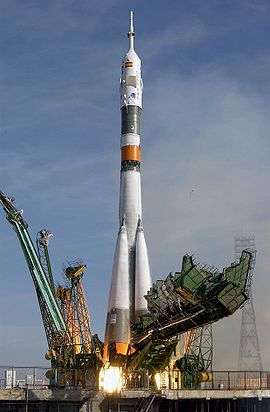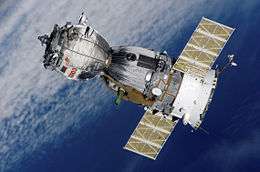Soyuz programme

| Part of a series of articles on the |
| Soviet space program |
|---|
 |
The Soyuz programme (/ˈsɔɪjuːz/ or /ˈsɔːjuːz/; Russian: Союз [sɐˈjus], meaning "Union") is a human spaceflight programme that was initiated by the Soviet Union in the early 1960s, originally part of a Moon landing project intended to put a Soviet cosmonaut on the Moon. It was the third Soviet human spaceflight programme after the Vostok and Voskhod programme.
The programme consists of the Soyuz spacecraft and the Soyuz rocket and is now the responsibility of the Russian Federal Space Agency. Since the retirement of the Space Shuttle in 2011, all human spaceflights to and from the International Space Station have been carried out using Soyuz.
Soyuz rocket

The launch vehicles used in the Soyuz expendable launch system are manufactured at the Progress State Research and Production Rocket Space Center (TsSKB-Progress) in Samara, Russia. As well as being used in the Soyuz programme as the launcher for the manned Soyuz spacecraft, Soyuz launch vehicles are now also used to launch unmanned Progress supply spacecraft to the International Space Station and commercial launches marketed and operated by TsSKB-Progress and the Starsem company. There were 11 Soyuz launches in 2001 and 9 in 2002. Currently Soyuz vehicles are launched from the Baikonur Cosmodrome in Kazakhstan and the Plesetsk Cosmodrome in northwest Russia and, starting in 2011, Soyuz launch vehicles can now also be launched from the Guiana Space Centre in French Guiana.[1] The Spaceport’s new Soyuz launch site has been handling Soyuz launches since 21 October 2011, the date of the first launch.[2] As of July 2014, 8 Soyuz launches had been made from French Guiana, all successful.
Soyuz spacecraft
The basic Soyuz spacecraft design was the basis for many projects, many of which never came to light. Its earliest form was intended to travel to the moon without employing a huge booster like the Saturn V or the Soviet N-1 by repeatedly docking with upper stages that had been put in orbit using the same rocket as the Soyuz. This and the initial civilian designs were done under the Soviet Chief Designer Sergei Pavlovich Korolev, who did not live to see the craft take flight. Several military derivatives took precedence in the Soviet design process, though they never came to pass.
A Soyuz spacecraft consists of three parts (from front to back):
- a spheroid orbital module
- a small aerodynamic reentry module
- a cylindrical service module with solar panels attached
There are several variants of the Soyuz spacecraft, including:
- Soyuz-A 7K-9K-11K circumlunar complex proposal (1963)
- Soyuz 7K-OK (1967–1970)
- Soyuz 7K-L1 Zond (1967–1970)
- Soyuz 7K-L3 LOK (1971–1972)
- Soyuz 7K-OKS (1971)
- Soyuz 7K-T or "ferry" (1973–1981)
- Soyuz 7K-T/A9 (1974–1978)
- 7K-MF6 (1976)
- Soyuz 7K-TM (1974–1976)
- Soyuz-T (1976–1986)
- Soyuz-TM (1986–2003)
- Soyuz-TMA (2003–2012)
- Soyuz-ACTS (2006)
- Soyuz-TMA-M (2010–2016)
- Soyuz MS (since 2016)
- Military Soyuz (P, PPK, R, 7K-VI Zvezda, and OIS)
- Soyuz P manned satellite interceptor proposal (1962)
- Soyuz R command-reconnaissance spacecraft proposal (1962)
- Soyuz 7K-TK (1966)
- Soyuz PPK revised version of Soyuz P (1964)
- Soyuz 7K-VI Zvezda space station proposal (1964)
- Soyuz OIS (1967)
- Soyuz OB-VI space station proposal (1967)
- Soyuz 7K-S military transport proposal (1974)
- Soyuz 7K-ST concept for Soyuz T and TM (1974)
Derivatives
The Zond spacecraft was another derivative, designed to take a crew traveling in a figure-eight orbit around the Earth and the moon but never achieving the degree of safety or political need to be used for such.
Finally, the Progress series of unmanned cargo ships for the Salyut and Mir space laboratories used the automatic navigation and docking mechanism (but not the re-entry capsule) of Soyuz.
While not a direct derivative, the Chinese Shenzhou spacecraft follows the basic template originally pioneered by Soyuz.[3][4]
Gallery
 Soyuz TMA-3 launch
Soyuz TMA-3 launch_spacecraft.jpg) Soyuz 19 as seen from the Apollo spacecraft during ASTP Mission July, 1975
Soyuz 19 as seen from the Apollo spacecraft during ASTP Mission July, 1975.jpg) Soyuz TMA-14M landing
Soyuz TMA-14M landing.jpg) Soyuz TMA-16M approaches the ISS
Soyuz TMA-16M approaches the ISS
Soyuz manned flights
Soyuz unmanned flights
| Flights 1–5 | Flights 6–10 | Flights 11–15 | Flights 16–20 | Flights 21–26 |
|---|---|---|---|---|
| 1. Kosmos 133 | 6. Kosmos 212 | 11. Kosmos 396 | 16. Kosmos 638 | 21. Soyuz 20 |
| 2. Launch failure | 7. Kosmos 213 | 12. Kosmos 434 | 17. Kosmos 656 | 22. Kosmos 869 |
| 3. Kosmos 140 | 8. Kosmos 238 | 13. Kosmos 496 | 18. Kosmos 670 | 23. Kosmos 1001 |
| 4. Kosmos 186 | 9. Soyuz 2 | 14. Kosmos 573 | 19. Kosmos 672 | 24. Kosmos 1074 |
| 5. Kosmos 188 | 10. Kosmos 379 | 15. Kosmos 613 | 20. Kosmos 772 | 25. Soyuz T-1 |
| 26. Soyuz TM-1 |
See also
| Wikimedia Commons has media related to Soyuz program. |
- Shenzhou, a Chinese spacecraft influenced by Soyuz
- Space Shuttle
- Buran (spacecraft)
- Space accidents and incidents
References
- ↑ "Soyuz & Vega at the Spaceport".
- ↑ "Galileo: Europe readies itself for October launch".
- ↑ Shenzhou-5 - Quick Facts. Astronautix.com. Retrieved on 2013-10-23.
- ↑ Archived December 2, 2010, at the Wayback Machine.


